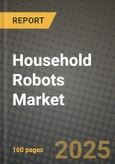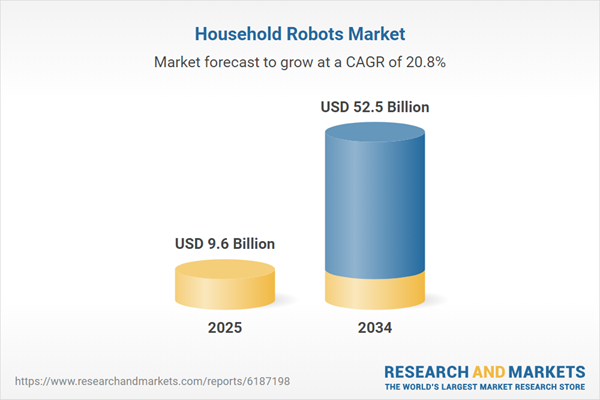The Household Robots Market is rapidly transforming the way consumers manage domestic tasks, offering smart solutions for cleaning, security, companionship, and home automation. These robots include robotic vacuum cleaners, lawn mowers, window cleaners, and even social or assistive robots for the elderly and children. The increasing integration of artificial intelligence, machine learning, and IoT connectivity has significantly improved the efficiency, autonomy, and intelligence of these devices. As busy lifestyles and aging populations drive demand for convenience and in-home support, the adoption of household robots continues to grow across developed and emerging markets. Brands are competing on features such as voice control, object recognition, mapping accuracy, and smart home compatibility. The affordability of entry-level models and expanded retail availability have also contributed to the market's growth, making household robots accessible to a wider range of consumers.
The Household Robots Market witnessed notable technological progress and broader adoption, particularly in North America, Europe, and parts of Asia. Robotic vacuum cleaners dominated the segment, with enhanced models featuring LiDAR navigation, real-time mapping, and multi-surface adaptability. Meanwhile, smart lawn mowers and window-cleaning robots gained popularity in suburban and urban households alike. Manufacturers introduced software updates and subscription-based services, such as predictive maintenance and performance analytics, to extend product life and enhance user experience. Home assistant robots with conversational AI capabilities began to bridge the gap between functional utility and companionship. Consumer preference shifted toward multifunctional robots that could handle multiple tasks simultaneously, driven by the desire for streamlined solutions and minimal device clutter. The year also saw increased interest in pet-care and elder-care robots, indicating a move toward more personalized household assistance solutions.
The Household Robots Market is poised for accelerated innovation, with robotics companies aiming to introduce more human-like capabilities and emotional intelligence in personal assistant robots. Advances in edge computing, sensor miniaturization, and battery efficiency will empower robots to operate more independently and safely within complex household environments. Integration with broader smart home ecosystems, including HVAC systems, security setups, and appliances, will enable household robots to function as central hubs for home automation. Additionally, global demand will rise as prices continue to fall and AI algorithms become more robust. In emerging economies, growing middle-class populations and increased digital literacy will drive first-time adoption. The market is also expected to see growth in niche segments, such as educational robots for children and health-monitoring robots for elderly care. With regulatory support and standardization improving across regions, household robots will become an indispensable part of everyday living in the near future.
Key Insights: Household Robots Market
- Multifunctional robots are trending, with single units now capable of vacuuming, mopping, and monitoring indoor air quality, appealing to users seeking comprehensive home care in one device.
- AI-driven personalization is shaping product design, enabling robots to learn user habits and preferences to deliver customized cleaning or assistance schedules.
- Voice-activated and gesture-controlled household robots are gaining momentum, enhancing user convenience and creating more natural human-machine interactions.
- Pet-focused robots, including automated feeders, litter cleaners, and pet-monitoring devices, are emerging as niche favorites among pet owners seeking reliable support.
- Subscription-based upgrades and services are expanding, offering users continuous software enhancements, troubleshooting assistance, and advanced analytics to improve device performance.
- Busy lifestyles and dual-income households are increasing demand for automated solutions that reduce time spent on daily chores and maintenance tasks.
- Rising elderly populations and the need for in-home care are driving the adoption of assistive robots that offer companionship, reminders, and health monitoring.
- Improvements in AI, sensor technology, and battery performance are making household robots more capable, autonomous, and efficient across diverse environments.
- Growing consumer awareness and acceptance of smart home technologies are creating a receptive market for robots that integrate seamlessly with connected ecosystems.
- High initial costs and concerns about long-term reliability continue to hinder widespread adoption in lower-income households, despite increased affordability of entry-level models.
Household Robots Market Segmentation
By Type
- Domestic
- Entertainment and Leisure
By Offering
- Products
- Services
By Application
- Vacuuming
- Lawn Mowing
- Pool Cleaning
- Companionship
- Elderly Assistance and Handicap Assistance
- Robot Toys and Hobby Systems
- Other Applications
Key Companies Analysed
- Dyson Limited
- Ecovacs Robotics
- Neato Robotics Inc.
- Alfred Kärcher SE & Co.
- LG Electronics Inc
- The Lego Group
- Samsung Electronics Co Ltd
- Husqvarna AB
- Deere & Company
- Xiaomi Corporation
- BSH Hausgeräte GmbH
- Miele Corporate
- Robomow
- Blue Frog Robotics
- iLIFE Innovation Ltd
- iRobot Corporation
- Maytronics Ltd.
- Neato robotics Inc.
- Hayward Holdings Inc.
- Panasonic Corporation
- Roborock Technology Co. Ltd
- bObsweep Inc.
- SharkNinja Operating LLC
- Schweitzer Engineering Laboratories
- Schneider Electric SE
- Opus One Solutions Inc.
- Encorp Inc.
- Siemens AG
- Schweitzer & Conrad Inc.
- Spirae LLC Company
- Emerson Automation Solutions
- CleanSpark Inc.
- Eaton Corporation
- General Electric Company
- .
Household Robots Market Analytics
The report employs rigorous tools, including Porter’s Five Forces, value chain mapping, and scenario-based modeling, to assess supply-demand dynamics. Cross-sector influences from parent, derived, and substitute markets are evaluated to identify risks and opportunities. Trade and pricing analytics provide an up-to-date view of international flows, including leading exporters, importers, and regional price trends.Macroeconomic indicators, policy frameworks such as carbon pricing and energy security strategies, and evolving consumer behavior are considered in forecasting scenarios. Recent deal flows, partnerships, and technology innovations are incorporated to assess their impact on future market performance.
Household Robots Market Competitive Intelligence
The competitive landscape is mapped through proprietary frameworks, profiling leading companies with details on business models, product portfolios, financial performance, and strategic initiatives. Key developments such as mergers & acquisitions, technology collaborations, investment inflows, and regional expansions are analyzed for their competitive impact. The report also identifies emerging players and innovative startups contributing to market disruption.Regional insights highlight the most promising investment destinations, regulatory landscapes, and evolving partnerships across energy and industrial corridors.
Countries Covered
- North America - Household Robots market data and outlook to 2034
- United States
- Canada
- Mexico
- Europe - Household Robots market data and outlook to 2034
- Germany
- United Kingdom
- France
- Italy
- Spain
- BeNeLux
- Russia
- Sweden
- Asia-Pacific - Household Robots market data and outlook to 2034
- China
- Japan
- India
- South Korea
- Australia
- Indonesia
- Malaysia
- Vietnam
- Middle East and Africa - Household Robots market data and outlook to 2034
- Saudi Arabia
- South Africa
- Iran
- UAE
- Egypt
- South and Central America - Household Robots market data and outlook to 2034
- Brazil
- Argentina
- Chile
- Peru
Research Methodology
This study combines primary inputs from industry experts across the Household Robots value chain with secondary data from associations, government publications, trade databases, and company disclosures. Proprietary modeling techniques, including data triangulation, statistical correlation, and scenario planning, are applied to deliver reliable market sizing and forecasting.Key Questions Addressed
- What is the current and forecast market size of the Household Robots industry at global, regional, and country levels?
- Which types, applications, and technologies present the highest growth potential?
- How are supply chains adapting to geopolitical and economic shocks?
- What role do policy frameworks, trade flows, and sustainability targets play in shaping demand?
- Who are the leading players, and how are their strategies evolving in the face of global uncertainty?
- Which regional “hotspots” and customer segments will outpace the market, and what go-to-market and partnership models best support entry and expansion?
- Where are the most investable opportunities - across technology roadmaps, sustainability-linked innovation, and M&A - and what is the best segment to invest over the next 3-5 years?
Your Key Takeaways from the Household Robots Market Report
- Global Household Robots market size and growth projections (CAGR), 2024-2034
- Impact of Russia-Ukraine, Israel-Palestine, and Hamas conflicts on Household Robots trade, costs, and supply chains
- Household Robots market size, share, and outlook across 5 regions and 27 countries, 2023-2034
- Household Robots market size, CAGR, and market share of key products, applications, and end-user verticals, 2023-2034
- Short- and long-term Household Robots market trends, drivers, restraints, and opportunities
- Porter’s Five Forces analysis, technological developments, and Household Robots supply chain analysis
- Household Robots trade analysis, Household Robots market price analysis, and Household Robots supply/demand dynamics
- Profiles of 5 leading companies - overview, key strategies, financials, and products
- Latest Household Robots market news and developments
Additional Support
With the purchase of this report, you will receive:- An updated PDF report and an MS Excel data workbook containing all market tables and figures for easy analysis.
- 7-day post-sale analyst support for clarifications and in-scope supplementary data, ensuring the deliverable aligns precisely with your requirements.
- Complimentary report update to incorporate the latest available data and the impact of recent market developments.
This product will be delivered within 1-3 business days.
Table of Contents
Companies Mentioned
- Dyson Limited
- Ecovacs Robotics
- Neato Robotics Inc.
- Alfred Kärcher SE & Co.
- LG Electronics Inc.
- The Lego Group
- Samsung Electronics Co Ltd.
- Husqvarna AB
- Deere & Company
- Xiaomi Corporation
- BSH Hausgeräte GmbH
- Miele Corporate
- Robomow
- Blue Frog Robotics
- iLIFE Innovation Ltd.
- iRobot Corporation
- Maytronics Ltd.
- Neato robotics Inc.
- Hayward Holdings Inc.
- Panasonic Corporation
- Roborock Technology Co. Ltd.
- bObsweep Inc.
- SharkNinja Operating LLC
- Schweitzer Engineering Laboratories
- Schneider Electric SE
- Opus One Solutions Inc.
- Encorp Inc.
- Siemens AG
- Schweitzer & Conrad Inc.
- Spirae LLC Company
- Emerson Automation Solutions
- CleanSpark Inc.
- Eaton Corporation
- General Electric Company
- .
Table Information
| Report Attribute | Details |
|---|---|
| No. of Pages | 160 |
| Published | October 2025 |
| Forecast Period | 2025 - 2034 |
| Estimated Market Value ( USD | $ 9.6 Billion |
| Forecasted Market Value ( USD | $ 52.5 Billion |
| Compound Annual Growth Rate | 20.7% |
| Regions Covered | Global |
| No. of Companies Mentioned | 34 |









